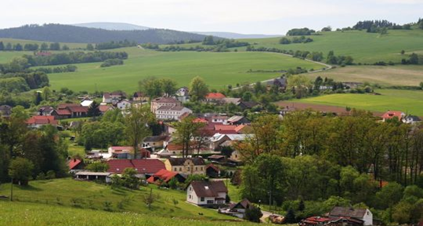

Dlouhá Ves is located 4 km south
of town Sušice/Schüttenhofen. Sušice was a prehistorically
established gold-washing settlement which was located near merchants’
route to Bavaria. In about the same time village Dlouhá Ves
(Lengthy dorp / de Longa Villa) was settled (first record 1290) around
the fortress.

In 1732 the fortress was
adapted into a baroque-styled chateau. In 1800 the estate became
property of Joseph Schwarzenberg. Since 1930 town hall owned the
castle. The building gradually deteriorated, and partly burnt. In 1949
the castle was torn down.
Jewish
settlement:
The first Jewish families settled in about the 2nd half of
17th century. In 1702 six percent of families in Langendorf were
Jewish. About 20 Jewish families lived throughout the 18th century; in
1849 it was 36 families (210 people). In 1837, about 26 houses were
owned by the Jewish owners. What was their profession? Mostly
merchants, one tabaktrafikant, few were distillers.

Soon
after - during civic emancipation - the Jewish families moved to bigger
towns. In 1880 there were 52 adults in Langendorf, (still 7% of total
population). The kehilah merged with the community of Kasperske Hory in
1890. In 1900 there were 28 adults (3%), in 1930 - 8 osob (less
than 1%). (According to other source there was no Jews in 1930
whatsoever.)
Synagogue:
- was built up
at the beginning of 18th century on the eastern side of Jewish street,
later refurbished into classicist style. The prayer hall was in 2nd
floor, used until 1924. It burnt in 1937 and later was demolished.
 |
 |
Family
history notes:
The Jewish quarter was located in the center of village, between the
farm and the church. Some of the houses still stand. According to
cadastre 1837, Bernard Schneider owned the house no. 2, Joseph
Schneider owned house no. XXI., Marcus Pick owned house no. XX.,
Joachim Pick owned house no. 51.
Jakob, the youngest son of Löbl Schneider was born in house no.
XVI. (1799). Seligman and his brother Joseph Pick were born in house
no.XX. (1823 and 1826, respectively). Bernard Schneider´s
children were born in house no.XXI (Joseph in 1834) and in no. 2
(Katharina in 1829, Jakob in 1836, Guttmann in 1838, Simon in 1839).
Cemetery:
Located 300 m SE
from the Catholic church. It was established at the beginning of 18th
century, the oldest readable tombstone is dated 1742. The cemetery was
used until the 30s of 20th century, also by the community in Kasperske
Hory.
The Nazis destroyed the whole cemetery and the tombstones were
transferred. In 1945 the tombstones were carried back and the cemetery
was reconstructed. There is a grave of 105 year-old Mathias Kraus
portrayed by Czech playwright J.K. Tyl in one his plays (1849).
 |
 |
The flat isolated rural
(agricultural) site has no sign or marker. Reached by turning directly
off a public road, access is open to all via no wall, fence, or
gate.
49 stones, none in original locations, date from 1742-19th century. The
granite and limestone flat shaped stones of baroque and classicist
style, finely smoothed and inscribed stones or flat stones with carved
relief decoration have Hebrew and German inscriptions. The cemetery
contains no known mass graves or structures. Plzen Jewish community
owns the Jewish cemetery. Adjacent properties are agricultural.
Occasionally, private visitors stop. Slight threat: weather erosion,
pollution and vegetation.

map of cadastre 1837

Copyright
©
2010
Julius
Müller